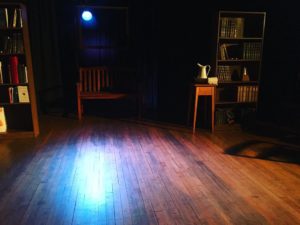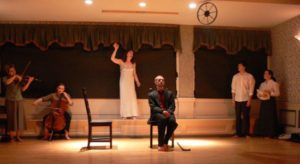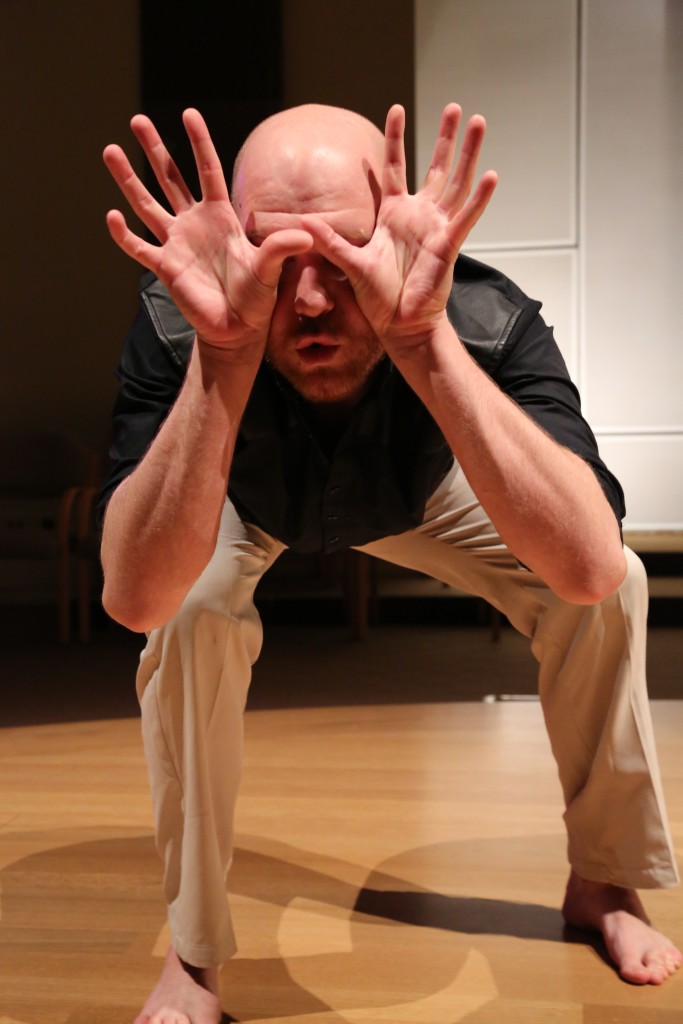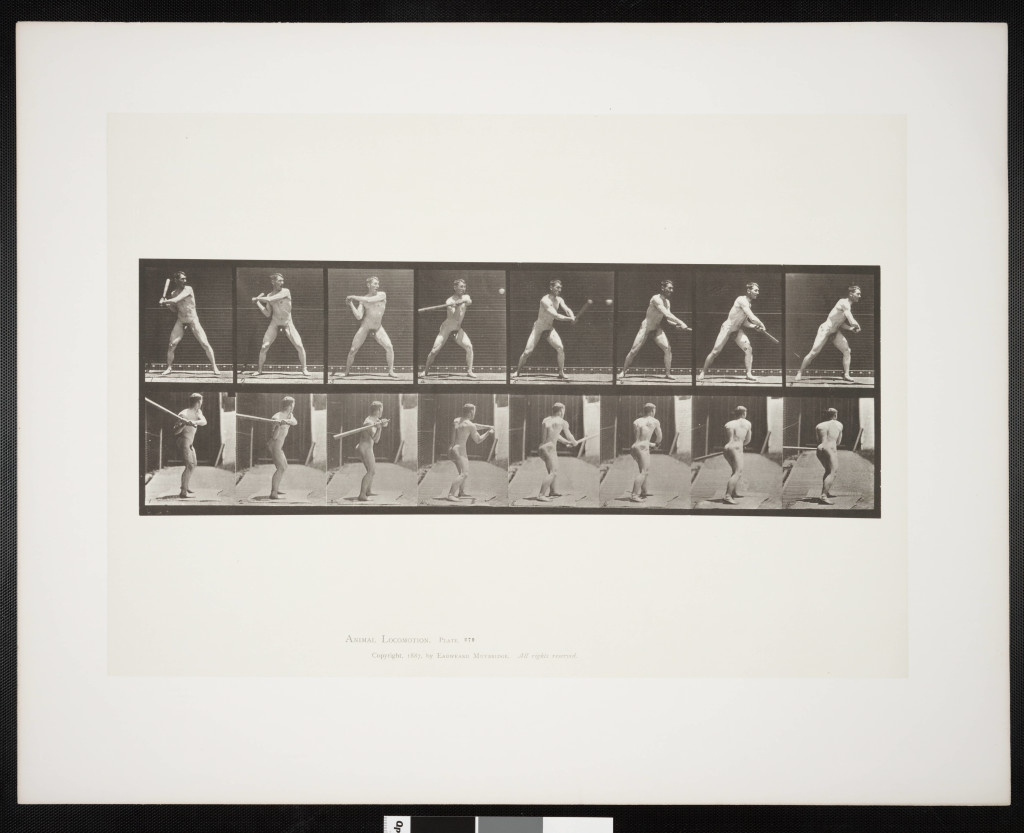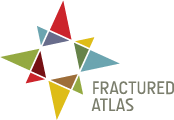Reflections on APL’s World Premiere Tour of Crime + Punishment
by Artistic Associate Tyler J. Polumsky
“I went back to Ohio… But my city was gone…”

Entrance to The Balch Street Theatre, home of New World Performance Laboratory (Akron OH) | Photo: Joseph Lavy
Chrissie Hynde of the Pretenders sang that way back in October 1982, on a B side, in lament for her hometown – Akron – and the changes that had turned the serene beauty of her childhood home into something unrecognizable.
Three and a half decades on, I also went [back] to Ohio, but my city was not gone. I went [back] to Ohio, but my family was not gone. No, no. My city was found, my family was there with me, and it just kept growing. For me, nothing was unrecognizable. It was, in fact, as if it was just waiting to be discovered.
There in Akron, you see, just west of downtown, is a little place on Balch Street.* Maybe a little run down. Maybe a little dusty. More than perfect for a theatre company to have as its own home.
A home is a vital thing for making our art. Not to be scoffed at. And this home is far more than most companies I know have.
“Ay… oh… way to go…”

Tyler Polumsky as Raskolnikov in the world premiere of Crime + Punishment | Balch Street Theatre, Akron OH | Photo: Margaretta Campagna
Enter New World Performance Lab.
NWPL is the kind of company you would expect to find in Europe. They are a well-established company. They have been cultivating and culturing their own audience for 25 years. Most of the core ensemble members have been working together for decades. They have their own space. They make art. They do not seem to care much for many of the fancy follies that theatre companies in big metros break themselves on. They have their own terms and direction, and it is Art. They are an intellectual and spiritual pillar of a community. Ten minutes with any of them is enough to make that clear.
Imagine designers who can take a pile of urban waste and turn it into minimalist stagecraft confection. Imagine a board op who prefers to run the light board manually because “The operator needs to be following and working with the actors, live, as a partner, on any given night.” Imagine actors who will let themselves be eaten alive by mosquitos before they will stop their training. The kind of folks who would jump on an actual boat with a pocket full of change, third class, en route to Europe, with dreams of working with Jerzy Grotowski unannounced — not only doing it but going on to become among his closest collaborators.
Imagine leaders who throw the doors open for you so you can premiere your show, who share their wine and guest rooms at home when it’s time to rest, and who put coffee on the next morning so you can get back to it.
“Ay, oh, way to go…”
So here, naturally, we from Akropolis Performance Lab, tired and road weary, jolly as ever, in this old community hall, in a beautiful and versatile space, surrounded by some excellent brothers and sisters in art, dug right in and premiered our adaptation of Dostoevsky’s Crime + Punishment to an audience hungry for theatre built on sweat, blood, and dynamic creativity rather than popped out of a can.
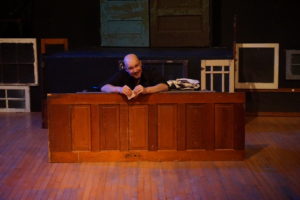
Tyler J. Polumksy as Raskolnikov in the world premiere of Crime + Punishment | Balch Street Theatre, Akron OH | Photo: Margaretta Campagna
in the world premiere of Crime + Punishment
in the world premiere of Crime + Punishment
It went well. How could it have gone otherwise, really, in such an inspired place, among inspired people?
APL and NWPL felt to me like long-lost siblings. This surprised me even though I knew APL’s co-founders were founding members of NWPL before moving to Seattle. The reunion of such things is profound, marked by joy and a mutual curiosity peppered with excitement.
We know ourselves by knowing each other, it seems.
And when you have an audience that has been cultivated, educated, and prepped for all of your experiments — an open audience, hungry for the resonating thought and questions your work will provoke — well, that is when theatre is really ready to happen.
And it did.
“…All my favorite places…”
Shortly before we went, a friend joked to me that going to Ohio to tour a show would be like going to Tashkent, Uzbekistan, where I had spent 10 years with the Ilkholm Theatre. I understood the dig: it’s not New York. Very clever.
“…My city had been pulled down… reduced to parking spaces…”
The thing is, he was right. He just wasn’t right in the way he intended.
“…I was stunned and amazed…”
What I found [back] in Ohio — what I have found in my artistic home with APL and recognized as equally potent in NWPL — is a little thing called inspiration (a little, ilkhom, if you are up on your Uzbek). The main ingredient for true Art. Actual artists who are busy being humans … not people just busy trying to be “Artists.” A space that is begging for a life and roaring back in unexpected places. A theatre that functions as a human institution rather than merely a civic or historical one.
So, yeah — a little like going [back] to Tashkent.
And why shouldn’t a place like this be found in America’s heartland? All roads lead to Ohio. Check a map. Follow any national election. Read the history. Ohio is at the center — “The Heart of It All!” as the state slogan goes.
What a setting! Deep in the heart of the American Beast, at a historically dire and dark time, APL was making some bone-biting theatre. Right there in Ohio.
I went back to Ohio, and my city was right there.
I went back to Ohio, and my family was right there with me, and growing.
And I’ll go back to Ohio, my pretty countryside.
“Ay… Oh… Way to go… OHIO”


